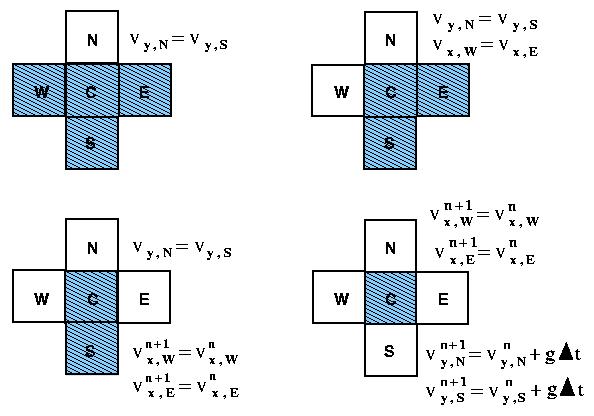


Home
Back to book

|
Franz J. Vesely:
Computational Physics - An Introduction
Second Edition
Kluwer Academic / Plenum Publishers, New York-London 2001.
ISBN 0-306-46631-7
|
Here are a few errata I have detected since publication
| |
Es irrt der Mensch, solang er strebt
[Goethe]
If anything can go wrong, it will
[Murphy]
|
Status: Sep-04
Page 34:
Equation 2.53 should read
[May 02; thanks to Steve Knudsen]
Page 34:
Equation 2.58 should read
[and in 2.59, the last  should be a superscipt]
should be a superscipt]
[May 02; thanks to Steve Knudsen]
Page 39:
Equation 2.72 should read
(Note that
 ). Accordingly, eq. 2.75 should be
). Accordingly, eq. 2.75 should be
With these corrections the example calculation following eq. 2.77 converges
faster - as it should.
[Sep 04; thanks to Greg Hammett]
Page 82:
The last five lines should read:
In our simple example
the fitness is bound to the value
 :
the lower
:
the lower  , the higher the fitness of
, the higher the fitness of  . It is always
possible, and convenient, to assign the fitness
. It is always
possible, and convenient, to assign the fitness
 such that it is positive definite.
such that it is positive definite.
A relative fitness, or probability of reproduction, is defined as
 . It has all the markings of
a probability density, and accordingly we may also ...
. It has all the markings of
a probability density, and accordingly we may also ...
[Dec 03]
Page 117:
Equ. 4.153 should read:
- Somewhat later, the sentence beginning ``Incidentally, ..''
should read:
A very similar first-order symplectic scheme, also
known as the Euler-Cromer algorithm,
exactly conserves the perturbed Hamiltonian
When applied to oscillator-like
equations of motion it is a definite improvement
over the (unstable) Euler-Cauchy method ...
[Dec 03, thanks to Denis Donnelly]
Page 154:
Equ. 5.137 is printed as
but should read
Note: the same error appears in Hockney's book
[Jan 04, thanks to the class of 03/04]
Page 168:
The text following equ. 6.8 should read
... where
 and ...
and ...
[Oct 03]
Page 187:
Eq. 6.60: the second term in the brackets should read
 |
(1) |
[Apr 06]
Page 217:
Eq. 8.12: should be
[May 06]
Page 218:
Eq. 8.18: first line should be
[May 06]
Page 232:
In Figure 8.6 the shading of some cells is barely visible.

MAC method: the 4 types of surface cells and the
appropriate boundary conditions for  (see POTTER).
(see POTTER).
[May 02]


 F. J. Vesely / University of Vienna
F. J. Vesely / University of Vienna





 ). Accordingly, eq. 2.75 should be
). Accordingly, eq. 2.75 should be

 . It has all the markings of
a probability density, and accordingly we may also ...
. It has all the markings of
a probability density, and accordingly we may also ...

![\begin{displaymath}
\beta_{l}= 2 \cos\left[ \frac{2(l-1)\pi}{2^{p+1}}\right]
\end{displaymath}](img18.png)
![\begin{displaymath}
\beta_{l}= 2 \cos\left[ \frac{(2l-1)\pi}{2^{p+1}}\right]
\end{displaymath}](img19.png)


